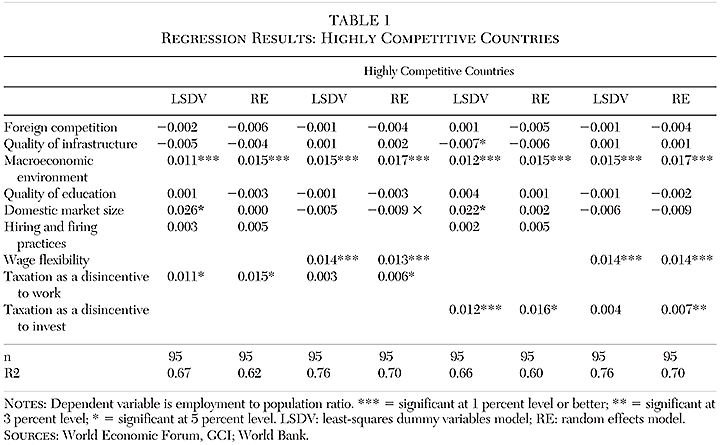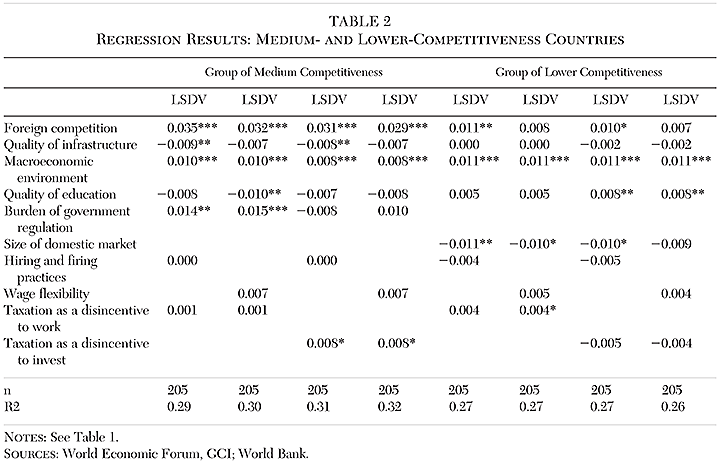Impact of Taxes on Employment and the Labor Income Share
The impact of taxes on employment and labor’s share of income has received attention in seminal work like Ramsey (1927), Mirrlees (1971), Hall (1973), Rosen (1979), Hausman (1980, 1981), Stern (1986), Hausman and Poterba (1987), Triest (1990), Feldstein (1995), and Diamond (1998). Over the years, the literature matured trying to overcome limitations posed by data availability and methodological challenges. Meghir and Phillips (2010), as well as Mankiw, Weinzierl, and Yagan (2009), summarized the key insights of the existing literature reflecting the simple reality that both income and substitution effects are at work.1 Manski (2012a, 2012b) is not alone in arguing that there is no certain answer to the question of what impact a tax increase has on labor.
In spite of the controversies found in the literature, there exists sufficient empirical evidence to suggest that increasing taxes on labor leads to a slowdown in economic growth and a decline in employment, as well as an encouragement of undeclared work (Davis and Henrekson 2004; Frederiksen, Graversen, and Smith 2005). This appears to be true at least for high-tax European and OECD countries (Planas, Roeger, and Rossi 2003; Bassanini and Duval 2006) and for more vulnerable population groups (Blundell 2012; Neumark and Shirley 2020).
The aforementioned studies often use household survey data, which are available for net earnings, and thus are able to focus directly on the impact of changes in net income on labor supply and equilibrium outcomes. These approaches mostly focus on within-group variation or on specific parts of the distribution of employees and incomes, and especially on kinks or policy-induced changes in parts of the tax wedge schedule. Thus, they can avoid identification problems, but other problems, such as the endogeneity of the earners’ distribution across income brackets, may persist.2
In recent decades, some researchers have argued that the stability of labor’s share of income has been declining due to technological change and, to a lesser extent, certain aspects of globalization (IMF 2017: chap. 3; Dao, Das, and Koczan 2019). Those trends are found to harm lower- and middle-skilled workers and jobs that are easy to routinize, but no definite consensus has been formed. Finally, some differentiation appears in this literature according to country groups, time, and the specifications of each analysis that includes a wide array of independent variables ranging from market regulation to education.
A number of the researchers who have investigated the labor income share have also tried to add the impact of taxation. Estrada and Valdeolivas (2012) examined the impact of taxes on labor income and did not find a statistically significant relationship. They argued that a nonwage component is included in the total compensation of employees, implying that an identification problem exists even before one can be concerned about endogeneity (Li and Lin 2016). Stockhammer (2013) included the tax wedge but failed to find a significant impact on the labor income share. In other research, the European Commission (2007: chap. 5) analyzed the impact of the tax wedge on specific subgroups and found an impact on lower- and upper-tier income employment groups.
A methodological issue that emerges when the labor income share is used is the need to account for the income attributed to self-employed labor but lumped with capital income by national accounts. This problem is commonly corrected by an assumption that the self-employed earn the same income as wage earners (Arpaia, Pérez, and Pichelmann 2009; European Commission 2007). In addition, according to researchers like Cho, Hwang, and Schreyer (2017), as capital becomes more important so does depreciation. Hence, labor income will inevitably decline relative to gross income, if this fact is not properly accounted for. We are not aware of research with such an adjustment that examines the impact of taxation.
In view of the above, we perceive an opportunity to use a survey from the World Economic Forum to study the relationship between taxation and employment levels at a macroeconomic level.
Insights from the World Economic Forum Survey
For the last several decades, the World Economic Forum has conducted an annual EOS among businesses in most countries, both developed and developing. For this survey, a questionnaire is distributed by local partners to a sample of local businesses that have to meet certain criteria to ensure representativeness by size and sectors. Furthermore, a minimum number of completed or largely completed surveys have to be received in order to ensure the inclusion of a country in the annual publication, with the WEF providing extensive details about the scope and technical execution of the survey (see, e.g., World Economic Forum 2014).
The questionnaires tend to be completed by high-ranking executives of companies that have a structure to deal with such questionnaires and, as a result, tend to be larger and part of the official economy. Therefore, it has to be noted that the answers provided may represent a different share of economic activity in each country according to its institutional maturity and the prevalence of the unofficial economy and thus estimated elasticities may be affected—for example, work on tax morale (Kaplow 2007; OECD 2019).
In this article, we are particularly interested in the EOS question asking executives “to what extent do taxes reduce the incentive to work?” In a ranking of 1 to 7, 1 = “significantly reduce the incentive to work,” while 7 = “do not reduce incentive to work at all.” Questions regarding the impact of taxation were included in the survey from 2013 until 2017.
This dataset allows us to avoid the endogeneity problem when the average tax wedge is used as an independent variable. In addition, the EOS covers almost all countries, which allows us to expand beyond the dataset for developed countries. Using the EOS response as a proxy for taxation, however, comes with a number of shortcomings: particularly, the inability to estimate elasticities using hard data. Nevertheless, we are encouraged by the fact that a previous use of EOS data by Feldmann (2003) led to results that were verified with the use of hard data, once the datasets were developed by the OECD (2004).
Even though we can pair a dependent variable that is not affected by the tax wedge with measures of taxation and that can be used in a macroeconomic analysis, we are still missing data and a theoretical justification that would allow us to remove the tax wedge from the labor share of income even after correcting for depreciation and self-employment. Therefore, we will use as a dependent variable the World Bank employment to population ratio (i.e., the percentage of working age population employed), even though this means we will investigate only the number of jobs and ignore qualitative aspects of these jobs. In the end, in spite of the limitations still present, the closer examination of the WEF EOS dataset promises to provide some useful insights.
The aggregate WEF Global Competitiveness Index (GCI) shows that for the upper tier of developed countries, which includes members of the European Union (EU) and OECD, a clear negative relationship exists between the ranking of taxation as a disincentive to work and the employment rate of the population as reflected by the five-year averages of the available panel data for these countries. At the same time, it is interesting to point out that for countries that rank lower, including also some EU members, the relationship is gradually weakened.
The deterioration of the results as countries ranked at lower competitiveness and institutional maturity are included in the sample is interesting but not novel (Stockhammer 2017). Furthermore, Bassanini and Duval (2006, 2009) found a strong intuitive relationship between unemployment and the OECD tax wedge by focusing on averages in 20 OECD countries. Even though the separation of a dataset in subgroups may be considered arbitrary, we proceed as such a separation allows a comparison of findings among the group of highly competitive countries with groups of less competitive countries. In addition, we observe no highly competitive countries in which an unfavorable ranking by the WEF EOS on the issue of taxation is paired with a relatively high employment ratio.3
Analysis of the Dataset
Following a number of separate regressions, we split the sample of 101 countries for which both WEF and World Bank data were available into three groups:4 (1) 41 lower-ranking countries using the WEF GCI, generating 205 data points; (2) 41 middle-ranking countries with 205 data points for all five years covered by our data; and (3) the top-ranked 19 countries.5 The top group was selected with a threshold that marked a trend to reduce the robustness of the results once lower-ranking countries were included and Luxemburg and Malaysia were removed, as their attributes appeared to show performance not explained well by the independent variables.
Our independent variables are all selected from the WEF GCI subindexes. Numerous subindexes were tried in a way that gave precedence to variables that represent answers to EOS questions and that touch topics that are related with variables identified as relevant in the literature. Broader indexes of the WEF GCI that bundle a number of selected per case subindexes, and incorporate statistical data with results of the EOS, were also tried. In the end, some of the broadest so-called pillars of the WEF GCI were selected as they offered a consistent approach and the results obtained remained intuitively compatible. However, in order to ensure desired properties—such as exogeneity of the independent variables, reduced vector inflation factors, and increased relevance in certain country groups—some subindexes were selected. Thus, the pillar “goods market efficiency” was removed, the pillar on infrastructure was replaced by “quality of infrastructure,” and the subindexes on “foreign competition” and “domestic market size” were included as representative of the pressures of globalization and the ability to cater to a large nontradables sector. Also, the pillar on “labor market efficiency” was replaced by either “hiring and firing practices” or “flexibility of wages,” because that pillar includes the tax wedge. Finally, measures of access to finance were not used given their correlation with the pillar for the macroeconomic environment.
Regarding the endogeneity of the independent variable, the view of executives regarding “taxation as a disincentive” to work and invest, a two-stage least squares regression was performed adding the EOS answers on “government efficiency” and the “the existence of irregular payments” that were statistically significant in many iterations. For the group of middle-ranked countries, “domestic market size” was replaced by “burden of government regulation.” The latter, especially in the group of highly competitive countries, demonstrated high multicollinearity and endogeneity, reminding us of arguments that the relationship between taxation and regulation can be an influencing factor (Schoefer 2010). The variables finally included, and the results obtained by the relevant least squares dummy variable (LSDV) and random effects approaches are shown in Tables 1 and 2.


